Safe-and-Sustainable-by-Design
Partly based on: Patinha Caldeira et al., 2022 (© European Union, 2022)
The EU Chemical Strategy for Sustainability (CSS) aims at fostering a transition towards safer and more sustainable chemicals. To ensure this transition, safety and sustainability considerations should be integrated when assessing existing chemicals as well as alternative chemicals that might substitute them.
There is, therefore, the need to develop a new framework for the definition of criteria for SSbD chemicals and materials. A framework for SSbD requires the integration of risk assessment and safety-based considerations with life cycle-based consideration, to ensure sustainability along the entire value chain. (Patinha Caldeira et al., 2022)
Table of contents
Strategic planning
Strategic Research and Innovation Plan for safe and sustainable Chemicals and Materials 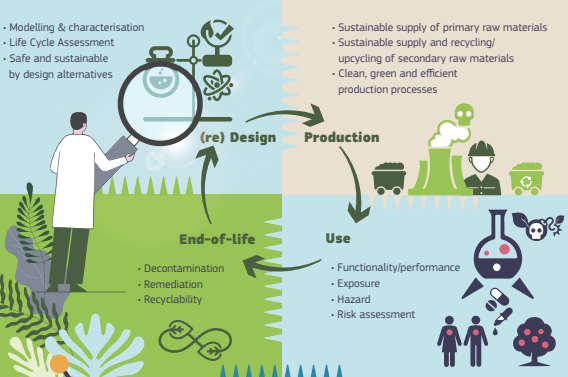 The current Strategic Research and Innovation Plan (SRIP) delivers on this announcement and highlights current research and innovation (R&I) areas crucial for accelerating the transition to chemicals and materials that are safe and sustainable. The aim of the SRIP is to guide R&I funders in their decisions on investments across EU, national and private funding programmes. It is an opportunity for a more transparent communication among all relevant actors on joint R&I priorities proposed by the wider community: from academia to SMEs, large-scale industry, regulators and policymakers.
The current Strategic Research and Innovation Plan (SRIP) delivers on this announcement and highlights current research and innovation (R&I) areas crucial for accelerating the transition to chemicals and materials that are safe and sustainable. The aim of the SRIP is to guide R&I funders in their decisions on investments across EU, national and private funding programmes. It is an opportunity for a more transparent communication among all relevant actors on joint R&I priorities proposed by the wider community: from academia to SMEs, large-scale industry, regulators and policymakers.
Collection of concept documents and webinars related to SSbD by the EU and the OECD
Safe and Sustainable by Design case studies The European Commission presents an overview of the proposed SSbD framework application to case studies, in order to evaluate the applicability of the framework in assessing existing chemicals and to identify challenges and limitations to be addressed in future stages.
Second day
Working definitions of SbD
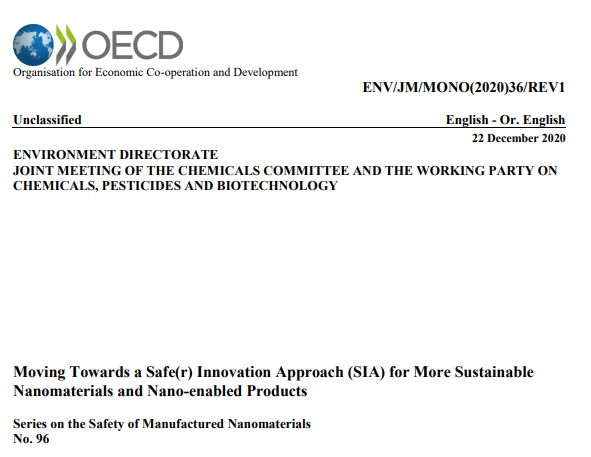 reproduced from:
reproduced from:
Moving Towards a Safe(r) Innovation Approach (SIA) for More Sustainable Nanomaterials and Nano-enabled Products
OECD Environment, Health and Safety Publications, Series on the Safety of Manufactured Nanomaterials No. 96
© OECD, 2020
Safer-by-Design (SbD), also named Safe-by-Design or Safety-by-Design, is one of the terms used in different industrial fields and geographical areas to refer to essentially the same concept of reducing the various types of risks of materials, constructions and products at the design stage. The risks addressed range from accidents (e.g. tunnel or occupational safety) to the intrinsic toxicity hazards of chemicals and materials. Some other terms have also been used recently in the field of nanotechnology [e.g. Prevention through Design (PtD), green nanotechnology]. Both of the forms “Safer-by-Design” and “Safe-by-Design” have been used interchangeably at least since the 1990s in e.g. construction industry and road tunnel safety, thus predating the use of the concept in the nanotechnology context, and both forms continue to be used today. The use of the term “safer” rather than “safe” emphasises the unattainability of absolute safety (Fadeel, 2013)(Hjorth et al., 2017)(Schwarz-Plaschg et al., 2017), while the use of “safe” sets a clearer end goal than the ongoing incremental steps suggested by the term “safer”.
Safe(r)-by-Design
The SbD (Safe-by-Design, Safer-by-Design, or Safety-by-Design) concept refers to identifying the risks and uncertainties concerning humans and the environment at an early phase of the innovation process so as to minimize uncertainties, potential hazard(s) and/or exposure. The SbD approach addresses the safety of the material/product and associated processes through the whole life cycle: from the Research and Development (R&D) phase to production, use, recycling and disposal.
Safety to human health and the environment is always relative rather than absolute. SbD strives for negligible human and environmental safety risks through an acceptable balance between safety, product functionality, and, as far as possible, costs, while meeting any applicable regulatory requirements for human and environmental safety and taking into account how the specific aspects of the innovative material/product may affect safety. In addition, the SbD approach helps to produce the safety-related information and data needed in order to comply with regulatory requirements and effectively communicate on any remaining risks.
Regulatory Preparedness
Regulatory Preparedness refers to the capacity of regulators, including policymakers, to anticipate the regulatory challenges posed by emerging technologies such as nanotechnology, particularly human and environmental safety challenges. This requires that regulators become aware of and understand innovations sufficiently early to take appropriate action, and that appropriate regulatory tools are modified or developed as needed. Regulatory Preparedness helps to ensure that innovative materials and products undergo suitable (and if appropriate, adapted) safety assessment before entering the market.
Regulatory Preparedness requires dialogue and knowledge-sharing among regulators and between regulators and innovators, industry and other stakeholders. This communication and interaction help regulators to anticipate the need for new or modified regulatory tools, and reduce the uncertainties for innovators and industry associated with the future development of the safety legislation and regulations applicable to emerging technologies.
Safe(r) Innovation Approach (SIA)
The Safe(r) Innovation Approach (SIA) combines the Safe(r)-by-Design and Regulatory Preparedness concepts in order to identify and minimize the possible health and environmental risks of innovative materials, products, applications, and processes in a timely manner during the innovation process. SIA addresses regulatory requirements for safety, including any necessary adaptations to cover the specific properties of materials or technologies. SIA thus relies on dialogue between industry and regulators and, as appropriate, other stakeholders. This dialogue ideally starts at an early stage of the innovation process and is facilitated by a Trusted Environment.
Trusted Environment
A Trusted Environment (TE) is a physical or virtual space in which industry, innovators and governmental institutions and, as appropriate, other stakeholders can share and exchange knowledge, information and views on new technologies, such as innovative nanomaterials and nano-enabled products. A TE invites trust by ensuring confidentiality and protecting intellectual property. Information-sharing through a TE is motivated by mutual benefit (e.g. reduced uncertainty), and entails some pre-requisites:
- Appropriate technical conditions that give organisations control over the process of information sharing (anonymity, logging of actions etc.)
- Juridical certainty to safeguard the information exchange process (non-disclosure agreements, regulations etc.)
- Clarity and agreement about rules of behaviour on dealing with the obtained information (Code of Conduct).
When these requirements are complied with and confidentiality as far as requested by the participants is maintained, a TE stimulates transparency and openness on the exchanged information.
What is SSbD exactly and how should it be implemented? - some expert opinions
Safe And Sustainable-By-Design @European Commission 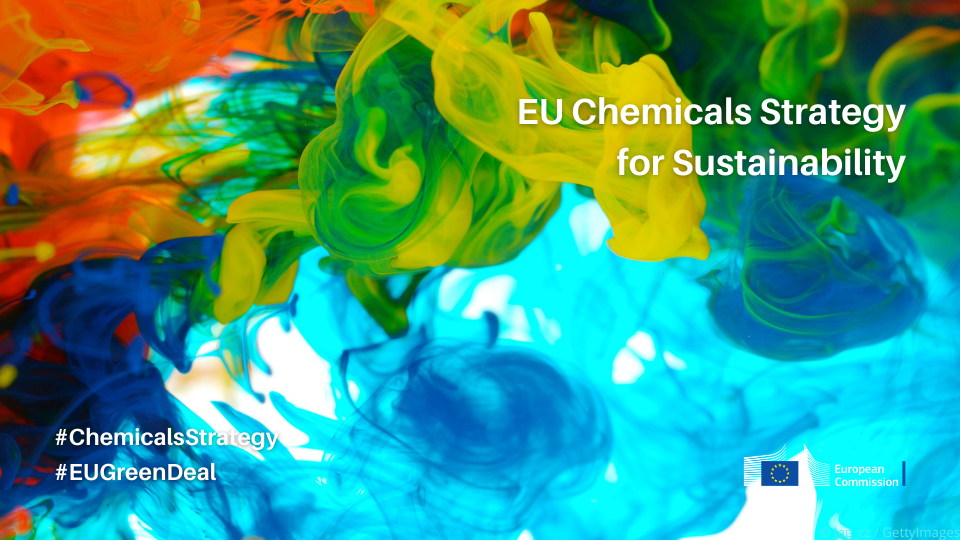 The European Commission introduced ‘safe and sustainable by design’ (SSbD framework) as a voluntary approach to guide the innovation process for chemicals and materials based on muliple reports from the EU Joint Research Centre. It then encouraged the engagement of relevant and willing stakeholders to support the progress of SSbD and adapt their innovation processes. Testing phases and stakeholder engagement workshops continue to establish a joint scientific reference base for safety and sustainability assessments that are necessary for innovation processes.
The European Commission introduced ‘safe and sustainable by design’ (SSbD framework) as a voluntary approach to guide the innovation process for chemicals and materials based on muliple reports from the EU Joint Research Centre. It then encouraged the engagement of relevant and willing stakeholders to support the progress of SSbD and adapt their innovation processes. Testing phases and stakeholder engagement workshops continue to establish a joint scientific reference base for safety and sustainability assessments that are necessary for innovation processes.
Safe and Sustainable by Design chemicals and materials - Methodological Guidance
2nd Safe and Sustainable by Design stakeholder workshop
Safe And Sustainable By Design @CEFIC The European Chemical Industry Council and its members sees “Safe and sustainable-by-design” as a process to accelerate widespread market uptake of new and alternative chemical products and technologies that deliver greater consumer confidence in their safety, environmental and societal benefits and advance the transition towards a circular economy and climate-neutral society. They have been actively engaging and collaborating to define Safe and Sustainable by Design (SSbD) and its criteria, which are available in the form of two reports and a recently published guidance.
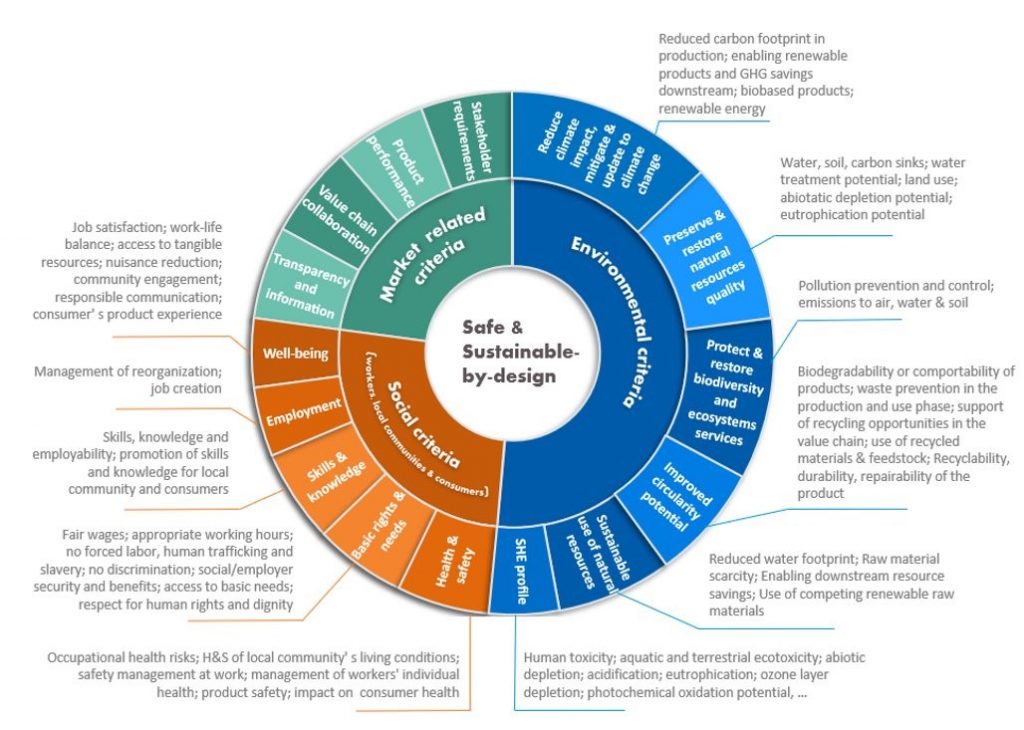
SAFE AND SUSTAINABLE BY DESIGN: A GUIDANCE TO UNLEASH THE TRANSFORMATIVE POWER OF INNOVATION
SAFE AND SUSTAINABLE BY DESIGN: A TRANSFORMATIVE POWER
SAFE AND SUSTAINABLE BY DESIGN: BOOSTING INNOVATION AND GROWTH WITHIN THE EUROPEAN CHEMICAL INDUSTRY
Steps in the approach to safe and sustainable design - European Environment Agency (EEA) Why should products be safe and sustainable by design?
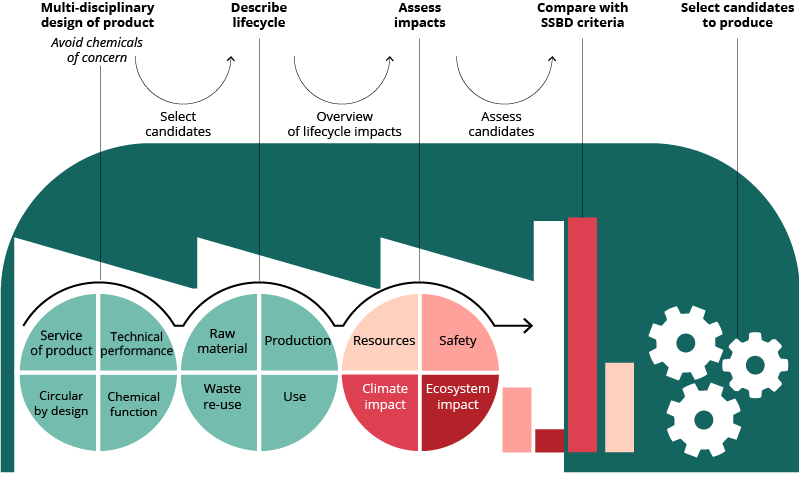 Making products safe and sustainable by design has the potential to improve product safety, prevent pollution, mitigate climate change and enable a circular economy. This entails assessing product performance against requirements for safety and sustainability at the design stage of product development, rather than after a product has been designed and is on the market. During the design phase, product engineers have more flexibility to innovate to meet performance objectives for safety and sustainability. An upstream approach is more efficient and effective than having to address deficiencies at the end of the product development process.
Making products safe and sustainable by design has the potential to improve product safety, prevent pollution, mitigate climate change and enable a circular economy. This entails assessing product performance against requirements for safety and sustainability at the design stage of product development, rather than after a product has been designed and is on the market. During the design phase, product engineers have more flexibility to innovate to meet performance objectives for safety and sustainability. An upstream approach is more efficient and effective than having to address deficiencies at the end of the product development process.
While the development of methodologies for delivering approaches to safe and sustainable design remain in the early phases, key steps in the product design process can be described …
Hear nano-specific SSbD definitions from speakers of SABYDOMA’s “A Stakeholder’s Perspective of Safe-and-Sustainable-by-Design” workshop 18 Feb. 2022

Safe-by-design and EU funded NanoSafety projects: Report on the EU nanomaterial SbD landscape in 2021
The report was delivered to the European Commission as a contribution of the EU NanoSafetyCluster (NSC) to answer the request to contribute to their study on the state-of-the-art and ongoing research in the field of Safe-and-Sustainable-by-Design.
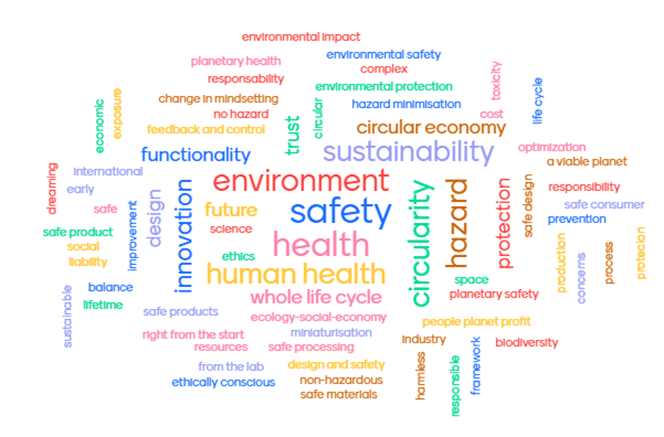
Safety aspects are amongst others very important to be addressed in the research, development and innovation (R&D&I) along the entire development chain, and specifically already from the earliest possible stages onwards. Considerable experience and knowledge have been gained in recent years tailored to nanomaterial related safety aspects. This enables the entire development and manufacturing areas to reduce delays to market launch of a product while extending their design processes to Safety and Sustainability by Design (SSbD). SSbD concepts and solutions developed in the nanotechnology area have the potential to become an essential asset in the future SSbD approach. Hence, several EU-funded projects in the frame of H2020 have already begun to integrate such aspects into their activities. Application- and/or product-oriented frontrunner-projects (e.g R2R Biofluidics-project1) have already incorporated sustainability aspects [in relation to theUN SDGs]. In other projects, case studies have been performed and initial discussions on safe innovation approach took place. In a few ‘closer-to-the-market’ projects (e.g. OITBs) this has been included specifically. Of course, it is needed to further advance current SbD tools and models to be future proof. Thus, the H2020 projects that address SbD aspects either on materials- and models-level, as well as on complex systems, have to support the further development by implementing this in the standard development process, and in parallel, shall contribute to the establishing a nano risk governance council and a sustainable nanofabrication community. Furthermore, a key issue to implement SbD is data. To enable SbD-implementation, all the knowledge needs to be handled according to the “FAIR”-principles to secure its access and use in the long-run, connected with European initiatives (e.g. EOSC, EUON), made operational via an umbrella infrastructure (i.e. NanoCommons) that shall be the organisational center to include or make accessible all data from finished and/or ongoing H2020 (e.g. PROCETS, caLIBRAte, ACEnano, Purenano, Hi-Accuracy, etc.) as well as future projects that will be funded under Horizon Europe.
Supporting S(S)bD
During the final phase of H2020 and the first years of Horizon Europe, SbD for nanomaterials and then SSbD for many material sectors including nanomaterials and now advanced materials has been the topic of many funding calls. Keeping up-to-date with all the developments of these projects is a project in itself. Therefore, we start here with some early references and hope to be able to update this soon.
Inventories of S(S)bD tools Collection of inventories with tools and services supporting SSbD e.g. from the OECD mapping study and JRC technical report linked above.
NanoCommons Safe-by-Design data and software platform interoperability and integration workshop 9 November 2021. Collaborative research supported by NanoCommons transnational access. More info…
Mapping study for the development of sustainable-by-design criteria The aim of this study is to map existing initiatives and R&I activities related to sustainability that are relevant for the development of sustainable-by-design criteria for chemicals, materials and products. It includes three main parts, 1) Identification of existing policies and initiatives that implement sustainability criteria, 2) Analysis of a sample of criteria under the relevant policies and initiatives with a focus on materials and chemicals, and 3) Analysis of the progress in R&I. (© European Union, 2021)
References
- Fadeel, 2013: Fadeel, B. Nanosafety: Towards Safer Design of Nanomedicines. Journal of Internal Medicine 2013, 274 (6), 578–580. https://doi.org/10.1111/joim.12137.
- Hjorth et al. 2017: Hjorth, R.; van Hove, L.; Wickson, F. What Can Nanosafety Learn from Drug Development? The Feasibility of “Safety by Design.” Nanotoxicology 2017, 11 (3), 305–312. https://doi.org/10.1080/17435390.2017.1299891.
- Patinha Caldeira et al., 2022: Patinha Caldeira, C.; Farcal, R.; Moretti, C.; Mancini, L.; Rauscher, H.; Rasmussen, K.; Riego Sintes, J.; Sala, S. Safe and Sustainable by Design chemicals and materials Review of safety and sustainability dimensions, aspects, methods, indicators, and tools, EUR 30991 EN, Publications Office of the European Union, Luxembourg, 2022. http://dx.doi.org/10.2760/879069.
- Schwarz-Plaschg et al., 2017: Schwarz-Plaschg, C.; Kallhoff, A.; Eisenberger, I. Making Nanomaterials Safer by Design? Nanoethics 2017, 11 (3), 277–281. https://doi.org/10.1007/s11569-017-0307-4.
